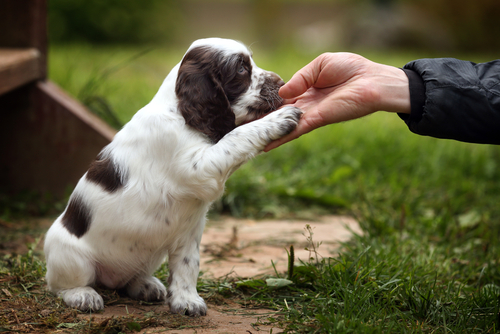Leading Young Puppy Educating Strategies to Make Certain a Mannerly Pet Dog
Efficient young puppy training is vital for cultivating a well-behaved companion, and various techniques can dramatically influence a canine's development. As we explore these approaches better, it becomes clear that the success of puppy training pivots on a mix of strategies that can transform your pet dog's actions in impressive means.
Positive Support Techniques
Using favorable support methods is crucial for effective young puppy training, as it urges wanted behaviors via incentives instead of penalty. This technique profits from the all-natural discovering procedures of canines, reinforcing etiquette by giving tangible and immediate benefits, such as deals with, praise, or play. By associating favorable results with details actions, pups are most likely to repeat those habits in the future.
Reliable favorable support includes timing and uniformity. Benefits need to be provided immediately after the desired habits happens to produce a clear link in the young puppy's mind. In addition, differing the kinds of rewards can preserve a puppy's passion and motivation throughout the training process. Some pups may react better to verbal appreciation while others might favor a preferred plaything or reward.

Consistency in Educating Commands
Keeping consistency in training commands is crucial for reinforcing the lessons found out with favorable reinforcement strategies. Canines thrive on regular and predictability, so utilizing the very same verbal commands and hand signals for particular behaviors is necessary. This harmony aids young puppies comprehend what is anticipated of them, decreasing confusion and aggravation for both the pet and the instructor.

Timing also plays a significant duty in consistency. Commands should be provided without delay during training sessions and complied with instantly by favorable support, such as treats or appreciation. This instant response aids strengthen the association between the command and the wanted actions.
Including uniformity right into training sessions will certainly create a secure learning atmosphere, advertising quicker mastery of commands. Eventually, a well-structured strategy cultivates a strong bond between the puppy and its owner, bring about a more loyal and well-behaved pet dog.
Socialization With Other Family Pets
Socializing with various other pet dogs is essential for a puppy's development, as it helps them learn suitable behaviors and interaction skills in diverse social contexts. Early interactions with various animals can substantially affect a young puppy's temperament and adaptability in different situations. When young puppies are revealed to a variety of pet dogs, they become more positive and much less frightened, which can avoid possible behavior concerns later in life.

Teach your pup to identify signals from other pets, such as signs of playfulness or pain, fostering common respect and understanding. Normal socialization not just improves your puppy's social abilities but likewise contributes to their total well-being, developing a more harmonious living setting.
Pet Crate Training Conveniences
Identifying the many benefits of cage training can greatly improve both the puppy's and proprietor's experience. Crate training offers a risk-free and safe environment for young puppies, ensuring they really feel safeguarded when left alone. This sense of security can significantly lower stress and anxiety and stress degrees for both the owner and the pet.
Furthermore, crates offer as a useful housebreaking tool. Pups normally avoid staining their sleeping area, thereby motivating them to hold their bladder until they are allow outdoors. This reaction can speed up the house-breaking process, fostering great routines at an early stage.
Crate training also aids in handling a puppy's actions when unsupervised. By giving a designated space, proprietors can stop harmful actions, such as eating on furnishings or getting involved in hazardous materials. Cages can be useful during travel, offering an acquainted area that news can aid soothe a young puppy in new environments.
Lastly, developing a crate regular urges freedom, allowing young puppies to discover how to be alone without worry. Overall, cage training is an effective approach for advertising technique, safety, and tranquility, bring about a well-adjusted, mannerly pet dog.
Leash Training Basics
Leash training is an essential element of accountable pet dog ownership that guarantees a secure and pleasurable walking experience for both the young puppy and its owner. Correct leash training starts early, preferably during the young puppy's socializing duration. When out in public., this training assists establish excellent behaviors and advertises positive actions.
To begin, pick a comfy collar or harness that fits your puppy well. Attach a strong chain, guaranteeing it is not as well long, as this can bring about pulling and irregular behavior. Start in a quiet setting to reduce disturbances and gradually present your puppy to brand-new surroundings.
Usage positive reinforcement strategies, such as treats and appreciation, to urge your puppy to walk beside you. If your pup pulls, quit walking and wait for them to return to your side prior to continuing.
Additionally, incorporate short training sessions with enjoyable disturbances to construct your young puppy's emphasis. With dedication and determination, leash training will certainly result in a well-mannered companion, making walks pleasurable for both the proprietor and the young puppy.
Verdict
In final thought, using effective pup training techniques is important for developing a well-behaved family pet. Generally, these methods collectively promote a harmonious connection between puppies and their owners.
As look what i found we discover these methods even more, it becomes clear that the success of puppy training hinges on a mix of methods that can change your pet's behavior in exceptional methods.
Making use of favorable support strategies is crucial for reliable pup training, as it motivates preferred behaviors with benefits instead than penalty.Crate training likewise aids in managing a pup's actions when unsupervised.Leash training is an essential aspect of liable family pet possession that makes certain a enjoyable and safe strolling experience for both the puppy and its proprietor.In verdict, using efficient puppy training techniques is essential for creating a well-behaved animal.